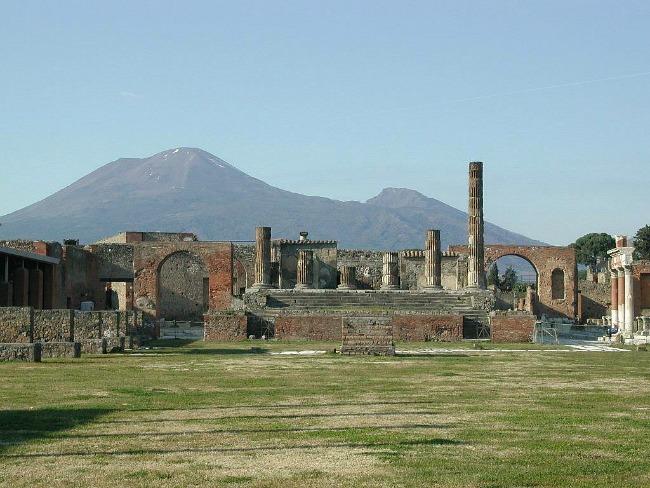Rolling down the A1 in a great big tour bus, I was desperately hoping that the toll road’s nickname—Highway of the Sun—would influence the day. We were on our way to visit (hopefully) Vesuvio, along with the largest of the four cities he destroyed in 79AD. The weather wasn’t particularly cooperative, however, with alternating stretches of rain and sunshine spoiling the view through the windshield, and threatening our hopes that the road to the volcano would be passable. But I’d choose rain every time, over the murderous clime of one hot August day 1,933 years ago.
That day, in the south of Italy, a low rumbling started, deep inside the mountain Vesuvio, named, some say, after a Greek word meaning “violence”—or possibly after a derivation of the name Zeus, the king of the Greek gods.
Soon enough, the rumble turned into a roar. The towering volcano, after eight centuries of silence, had chosen to erupt, spewing deadly clouds of unbreathable poison into the air, blowing southeast—straight toward some 20,000 residents of Pompeii.
The day before he blew, strangely enough, was a celebration day in honor of Vulcan, the god of fire, and, yes, volcanoes. Residents of Pompeii , Herculaneum, Stabiae and Oplontis—all annihilated by this powerful blast from below—likely offered the traditional animal sacrifices to try to appease this powerful god, who was thought to control both the beneficial and devastating aspects of fire.

Apparently, Vulcan was not appeased, as we saw at our first stop, Pompeii. Tour guide Willie led us through the ruins of simple homes, elaborate villas, an amphitheatre, a spa and a brothel, among other haunts and hangouts, after outfitting us with tiny earbuds so that we could hear his often humorous descriptions without having to walk right next to him. “We’re now at McDonalds,” he joked, as we marveled at the little shop with the sign “Termo-polium” (literally: “Warm, I sell”), where residents could buy servings of warm red wine with honey, and fish with a wildly popular garum sauce. There were ovens where bread was baked, a counter with built-in bowls for serving food, and even grooves for sliding doors that were opened during serving hours. Fast food, from around the time when Jesus walked the earth.
If anything good can be said about the disaster of 79AD, it is that the eight metres of ash and pumice covering Pompeii acted as a fine preservative. Most of the fine art and small household items—mosaics, paintings, lanterns, toiletries and the like—were taken to the Museo Archeologico Nazionale di Napoli, but you can still see several paintings in the buildings at the site, including a series of…shall we say... suggestive…frescoes in the town brothel. As Willie said, “If you don’t know what to do, the paintings will show you!” Indeed.
Jokes aside, the experience was sobering, especially the casts of bodies left behind, showing in clear detail the exact position people were in when they were smothered with volcanic ash—most of them curled into defensive positions, huddled against the horror. The casts were made by pouring plaster into the holes left by bodies that had decayed underneath the ash.

All the while, Vesuvio lurked above us, its shadowy mass mostly obscured by clouds. Toward the end of our tour at Pompeii, we learned that the road to the rim of the volcano had been officially closed due to the weather. I sensed a dissatisfied rumbling from members of the group, and was keenly disappointed myself, but before our feelings had the chance to erupt into something more sinister, Sarah, our guide, promised to take us to the archeological museum in Napoli instead.
This did not make me happy. I didn’t want to go there. I wanted to climb up a volcano. So I sulked on the bus back to Napoli, barely looking at the double rainbow stretching across the sky that the teenage girl sitting next to me pointed out. I was too busy feeling sorry for myself to appreciate any beauty the rain might have brought.
That is, until I walked up to the second floor of the Museo Archeologico Nazionale, and saw what had been unearthed from the ruins of Pompeii. First there were mosaics, fashioned from the tiniest bits of colored tile into large, bright masterpieces from the first century. Tiled representations of pugilists, roosters, beautiful women and skulls peered at me from the walls, some looking as though they’d been created yesterday. Household items were next: small lamps, delicately styled into animal and human personalities; vases and cooking pots; sets of silver. Most interesting were the sculptures: graceful bronze fauns, classic busts, winged beasts and a tiny bird, the same size—but much more beautiful—as one I’d sculpted in an amateur artistic fit a few days before. Suddenly, I had a connection—something in common with an artist from an ancient land, some 2,000 years ago. My self-pity was long gone, replaced by awe and genuine appreciation.

Back on the bus headed home to Rome, I realized that things always happen for a reason, even, dare I say, volcanoes. So maybe I wasn’t meant to climb to the top of Vesuvio. This day was about understanding more about an ancient community, and contemplating the tragedy vs. the opportunity for future generations to study history because of it.













